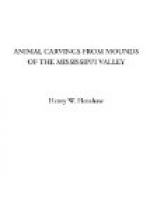KNOWLEDGE OF TROPICAL ANIMALS BY MOUND-BUILDERS.
The supposed evidence of a knowledge of tropical animals possessed by the ancient dwellers of the Mississippi Valley which has just been discussed seems to have powerfully impressed Wilson, and in his Prehistoric Man he devotes much space to the consideration of the matter. His ideas on the subject will be understood from the following quotation:
By the fidelity of the representations of so great a variety of subjects copied from animal life, they furnish evidence of a knowledge in the Mississippi Valley, of the fauna peculiar not only to southern, but to tropical latitudes, extending beyond the Isthmus into the southern continent; and suggestive either of arts derived from a foreign source, and of an intimate intercourse maintained with the central regions where the civilization of ancient America attained its highest development: or else indicative of migration, and an intrusion into the northern continent, of the race of the ancient graves of Central and Southern America, bringing with them the arts of the tropics, and models derived from the animals familiar to their fathers in the parent-land of the race. (Vol. 1, p. 475.)
The author subsequently shows his preference for the theory of a migration of the race of the Mound-Builders from southern regions as being on the whole more probable. Wilson does not, however, content himself with the evidence afforded by the birds and animals which have just been discussed, but strengthens his argument by extending the list of supposed exotic forms known to the Mound-Builders in the following words (vol. 1, p. 477):
But we must account by other means for the discovery of accurate miniature representations of it (i.e. the Manatee) among the sculptures of the far-inland mounds of Ohio; and the same remark equally applies to the jaguar or panther, the cougar, the toucan; to the buzzard possibly, and also to the paroquet. The majority of these animals are not known in the United States; some of them are totally unknown to within any part of the North American continent. (Italics of the present writer.) Others may be classed with the paroquet, which, though essentially a southern bird, and common in the Gulf, does occasionally make its appearance inland; and might possibly become known to the untraveled Mound-Builder among the fauna of his own northern home.
The information contained in the above paragraph relative to the range of some of the animals mentioned may well be viewed with surprise by naturalists. To begin with, the jaguar or panther, by which vernacular names the Felis onca is presumably meant, is not only found in Northern Mexico, but extends its range into the United States and appears as far north as the Red River of Louisiana. (See Baird’s Mammals of North America.) Hence a sculptured representation of this animal in the mounds, although by no means likely, is not entirely out of the question. However, among the several carvings of the cat family that have been exhumed from the mounds and made known there is not one which can, with even a fair degree of probability, be identified as this species in distinction from the next animal named, the cougar.




